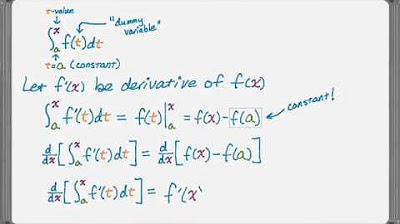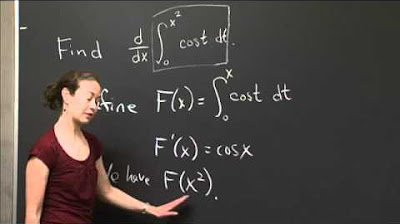Derivatives of Integrals (w/ Chain Rule)
TLDRThe video script discusses the Fundamental Theorem of Calculus, which is pivotal in understanding how to calculate derivatives of functions involving integration up to a variable. The theorem establishes that a function defined by the integral of another function is an antiderivative of the integrand. The script introduces a function 'a of X' as the integral from 3 to X of the function sine of T squared. It then demonstrates how to find the derivative of this function using the theorem, resulting in sine of X squared. The script further explores the application of the chain rule when the function involves a composition, such as e to the 2x, and illustrates the process of finding the derivative of a composite function. Lastly, it addresses how to handle definite integrals by expressing them in terms of the antiderivative function and applying the derivative with respect to the variable limits of integration. The explanation concludes with a simplified expression for the derivative of a third integral, showcasing the practical use of the Fundamental Theorem of Calculus in calculus problems.
Takeaways
- 📚 The Fundamental Theorem of Calculus allows us to find derivatives of functions that are integrated up to a variable.
- 🔢 The function defined by the integral of a function is an antiderivative of the function inside the integral.
- 🎓 The derivative of the integral function from a constant to X of a function is the integrand function itself.
- 📈 For the function a(X) = ∫ from 3 to X of sin(T)^2 dT, its derivative is sin(X)^2 by the Fundamental Theorem of Calculus.
- 📌 When evaluating a composition like a(e^(2x)), the Chain Rule is applied, multiplying the derivative of the outer function by the derivative of the inner function.
- 🔗 The Chain Rule states that the derivative of a composition is the derivative of the outer function evaluated at the inner function times the derivative of the inner function.
- 🧮 For the second function, the derivative is 2e^(2x) * sin(e^(2x))^2, which simplifies to 2e^(2x) * e^(4x).
- 🚀 The third function involves a definite integral, which is expressed as the antiderivative evaluated at the upper limit minus the antiderivative evaluated at the lower limit.
- ∫ For the third function, the derivative involves multiplying the derivative of the limits of integration by the antiderivative function evaluated at those limits.
- 🛠️ The antiderivative function a'(X) is used within the derivative calculation, applying the derivatives of the respective limits of integration.
- 🧹 Simplification is key when expressing the final derivative to make it more understandable and manageable.
- 📝 The process demonstrates how to use the Fundamental Theorem of Calculus to create antiderivatives and subsequently find derivatives based on variable limits of integration.
Q & A
What is the fundamental theorem of calculus?
-The fundamental theorem of calculus establishes the relationship between differentiation and integration. It states that if a function is continuous on the interval [a, b] and F is an antiderivative of f on [a, b], then the integral of f from a to b is equal to F(b) - F(a).
How does the fundamental theorem of calculus apply to the function a(x)?
-The fundamental theorem of calculus allows us to find the derivative of a(x), which is defined as the integral from 3 to x of the sine of t squared. The derivative of a(x) is the integrand function, which in this case is sine of x squared.
What is the antiderivative function a(x) in the given example?
-The antiderivative function a(x) is defined as the integral from 3 to x of the sine of t squared. It represents the accumulated value of the sine function from 3 up to the variable x.
How is the chain rule applied in the second problem?
-The chain rule is applied when finding the derivative of a composition of functions. In the second problem, the function is a evaluated at e to the 2x. The chain rule states that the derivative is the derivative of the outer function (a') times the derivative of the inner function (e to the 2x), which is 2e to the 2x.
What is the derivative of a(x) evaluated at e to the 2x?
-The derivative of a(x) evaluated at e to the 2x is found by applying the chain rule. It is 2e to the 2x times the sine of (e to the 2x) squared, which simplifies to 2e to the 2x times e to the 4x.
How is the fundamental theorem of calculus used to evaluate the third integral?
-The fundamental theorem of calculus is used to express the definite integral as the difference of the antiderivative function evaluated at two points, x cubed and the square root of x. The derivative of this expression is then found by differentiating each part with respect to x and applying the rules of differentiation.
What is the derivative of the third integral with respect to x?
-The derivative of the third integral is found by differentiating the antiderivative function a(x) with respect to x, and then multiplying by the derivative of the limits of integration. For the upper limit x cubed, it is 3x squared times the sine of x to the sixth. For the lower limit, the square root of x, it is one-half x to the negative one-half times the sine of the square root of x.
What is the final simplified form of the derivative of the third integral?
-The final simplified form of the derivative of the third integral is 3x squared times the sine of x to the sixth minus one over 2 square root of x times the sine of the square root of x.
How does the fundamental theorem of calculus relate to the process of finding antiderivatives?
-The fundamental theorem of calculus provides a method for finding antiderivatives by stating that the integral of a function can be represented as an antiderivative function evaluated at the limits of integration. This allows us to find the derivative of the antiderivative function, which is the original function we integrated.
What is the significance of the limits of integration in the process of finding derivatives of integrals?
-The limits of integration are crucial as they define the interval over which the integral is computed. When differentiating an integral, the derivative of the limits of integration must be taken into account, especially when the limits are functions of the variable of differentiation.
What is the role of the derivative of the input function in the process of differentiating a definite integral?
-The derivative of the input function is necessary when applying the rules of differentiation to the limits of integration. It is used to find the rate of change of the antiderivative function with respect to the variable of differentiation.
How does the chain rule help in differentiating more complex functions that are compositions of other functions?
-The chain rule allows us to differentiate composite functions by breaking down the differentiation process into steps. It states that the derivative of a composition of functions is the product of the derivative of the outer function and the derivative of the inner function.
Outlines
📚 Introduction to the Fundamental Theorem of Calculus
This paragraph introduces the fundamental theorem of calculus, highlighting its role in deriving the integral of a function with respect to a variable. The theorem is used to define a function, denoted as 'a of X', which is the integral from 3 to X of the function sine of T squared. The derivative of this function is shown to be the integrand function, sine of X squared, as per the theorem. The paragraph also discusses the application of the chain rule when evaluating the derivative of a composition, such as when the input is e to the 2x. The derivative in this case is calculated as 2 e to the 2x times the sine of the input squared, e to the 4x.
🔢 Derivatives of Definite Integrals and Antiderivatives
The second paragraph delves into the application of the fundamental theorem of calculus to definite integrals. It explains how a definite integral can be expressed as an antiderivative evaluated at different points, such as X cubed minus the antiderivative evaluated at the square root of X. The process of taking the derivative of such an expression involves multiplying the derivative of the input by the antiderivative function. For the given example, the derivative of the antiderivative function 'a prime' is used, which is the sine of the input squared. The derivative is then simplified by combining like terms and is expressed as 3x squared sine of X to the sixth minus 1 over 2 square root of X sine of X, showcasing the use of the fundamental theorem of calculus in creating antiderivatives and calculating derivatives based on variable limits of integration.
Mindmap
Keywords
💡Fundamental Theorem of Calculus
💡Derivative
💡Integral
💡Antiderivative
💡Chain Rule
💡Composite Function
💡Definite Integral
💡Sine Function
💡Variable Limits of Integration
💡Exponential Function
💡Square Root Function
Highlights
The fundamental theorem of calculus allows us to find derivatives of functions where we are integrating up to a variable.
The theorem tells us that a function defined by the integral of some function is an antiderivative of the function inside the integral.
The derivative of the integral function is the integrand function itself.
The function a(x) is introduced as the integral from 3 to x of sine(t) squared dt.
The derivative of a(x) is sine(x) squared, as per the fundamental theorem of calculus.
For the second problem, the chain rule is used instead of just the fundamental theorem of calculus.
The chain rule states the derivative of a composition is the outside function times the derivative of the inside function.
The derivative of a evaluated at e^(2x) involves using the chain rule and the derivative of e^(2x).
The final formula for the derivative in the second problem is 2e^(2x) * sin(x)^2 = 2e^(2x)e^(4x).
In the third problem, the definite integral is expressed in terms of the antiderivative function a(x) found using an integral.
The derivative of the definite integral involves multiplying by the derivative of the upper and lower limits of integration.
The derivative of a(x) is needed, which is sin(x)^2 * sin(t)^2 where t is the variable of integration.
The derivative of the upper limit x^3 is 3x^2, and the derivative of the lower limit sqrt(x) is 1/(2√x).
The final formula for the derivative of the third integral is 3x^2 * sin(x^6) - (1/(2√x)) * sin(x).
The fundamental theorem of calculus is used to create a function that is an antiderivative, and then its derivative is found based on the variable limits of integration.
The antiderivative function a(x) is key to finding the derivatives of integrals in these examples.
The chain rule is essential when the function being differentiated involves a composition, as in the second example.
The derivatives of the integrals are simplified for clarity in the final expressions.
Transcripts
Browse More Related Video

Second Fundamental Theorem of Calculus 2nd FTC

Calculus 1 - Integration: Proof of the Fundamental Theorem of Calculus

Finding derivative with fundamental theorem of calculus: x is on both bounds | Khan Academy

Worked example: Finding derivative with fundamental theorem of calculus | Khan Academy

Second fundamental theorem and chain rule | MIT 18.01SC Single Variable Calculus, Fall 2010

1st Fundamental Theorem of Calculus PROOF | Calculus 1 | jensenmath.ca
5.0 / 5 (0 votes)
Thanks for rating: